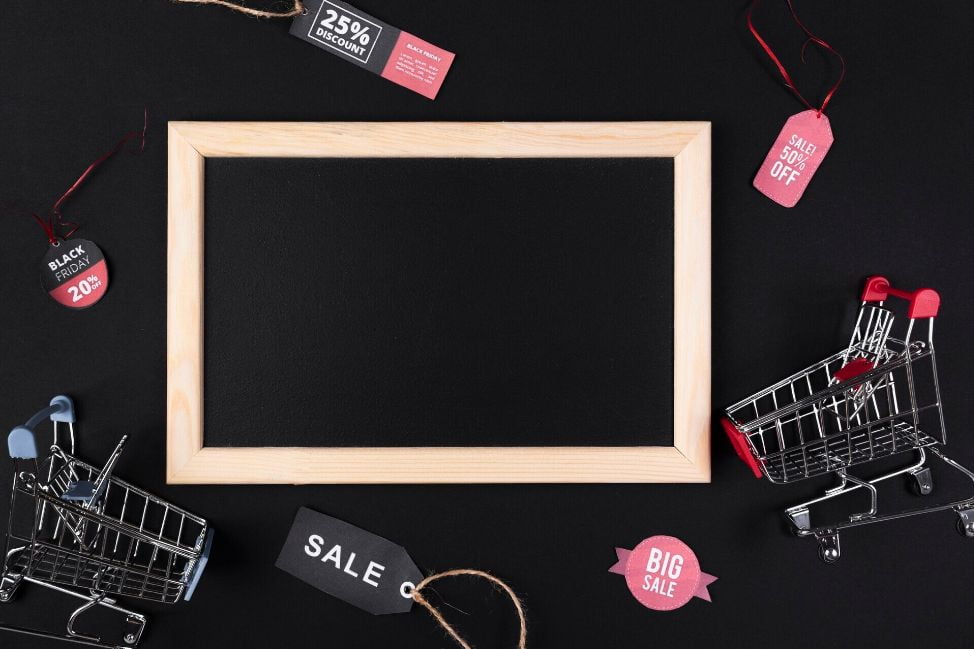The Importance of Holiday Marketing
Failing to push the gas on your holiday marketing campaigns means you’re missing out on the trillions that people spend collectively each holiday season.
In 2019, it’s reported that American household spending reached $1,496 during the Christmas holiday season. All of those purchases totaled more than $1.1 trillion, deemed as one of the biggest shopping periods ever recorded.
Your digital marketing campaigns should be delivered in places where big-spending holiday shoppers splash their cash. That way, you can get to the top of your customer’s minds when they’re thinking about purchasing gifts not just for their loved ones, but themselves, too.
In this guide, we’ll share nine holiday marketing strategies to help you master your next sales seasons.
1. Create a holiday calendar
When we think of the “holiday season”, events like Christmas, Black Friday, and Cyber Monday usually come to mind.
However, it’s not just holidays during the Winter season that you can create marketing campaigns around. Other holidays are huge spending opportunities for customers include:
- New Year
- Valentine’s Day
- Easter
- Mother’s and Father’s Day
- The 4th of July
- Back to School or College
- Halloween
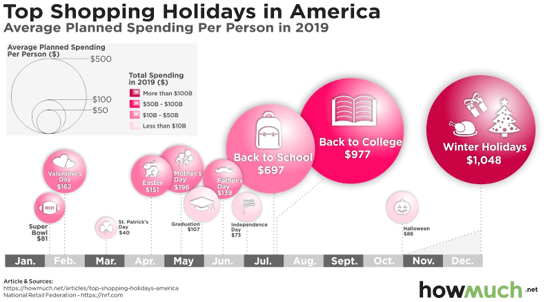
The problem is that creating new holiday marketing campaigns usually takes up to 12 weeks. Yet marketers are so occupied with other tasks that they huddle over their assets just one week before the holiday comes, making the holiday marketing campaign less successful.
That’s why it’s better to have a big calendar that plans out all the holidays you’ll be celebrating. Sendible’s holiday calendar is a great resource to bookmark if you don’t want to create your own.
2. Plan before the actual holiday
After adding the dates to your own calendar, you need to start turning the wheels on your new holiday campaigns way before the date rolls around.
Surprisingly, 35% of consumers start their holiday shopping before October ends:
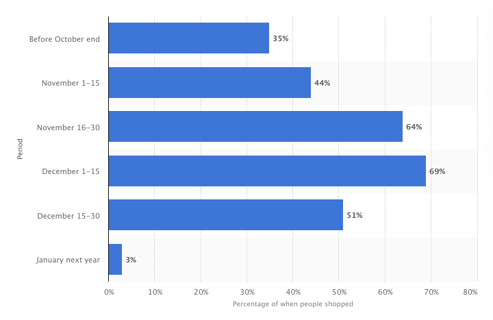
Planning your holiday marketing campaigns in advance gives you enough time to put together your course of action—including creating your marketing materials, setting-up automation, and checking everything works properly.
It also gives you enough time to look over any issues that might crop up during your planning. Any delay in creating assets, getting sign-off on budgets, can take more time than you originally planned.
So, the real question is: how far in advance should you plan your holiday marketing strategies?
Aim for three months beforehand if you have a fast, agile team. Six months prior to the event is a good timeframe if you’re a bigger marketing department whose sign-off process is lengthier.
3. Think of how customers shop during that holiday
Now we’ve got the holiday calendar prepared, and we know how far in advance to plan, it’s time to move onto the details.
This starts with understanding your target customer and how they shop during that specific holiday season. That has a huge impact on how you’ll promote your products before each big event.
For example:
- Millennials intended to spend $466 on Christmas gifts
- High-income households are more likely to shop online for Christmas gifts
- Baby boomers are expected to plan ahead and start shopping earlier than any other generation
Your holiday marketing campaigns for reaching each demographic would vary dramatically. A holiday marketing campaign targeting high-income households would prioritize their online campaigns, whereas one targeting baby boomers would release their marketing materials earlier than usual.
The same concept applies to other traits about your target buyer, too.
Things like payment methods and preferred marketing channels can all be affected by your target customer:
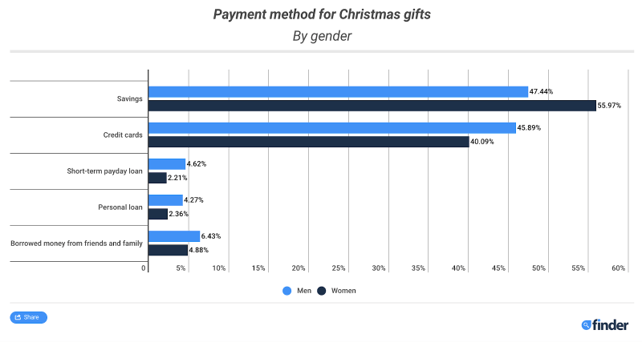
4. Consider any holiday sales or promotions
Did you know that 52% of customers look for promotions during the holiday shopping season?
That means promoting your coupons, discounts, or promotions could result in a holiday sale—even if they didn’t intend on buying from you.
Promotions can take many forms:
- Free shipping
- Discount or coupon codes
- Bundling products with a discount (e.g. three products for the price of two)
- Upselling (e.g. promoting a similar, higher-priced item at the checkout)
But regardless of what perks you’re offering, it can boost your ROI as long as it can sway customers into buying your products.
You can do this by treating the sales promotion as the copy for your campaigns. Use it as your Facebook Ads headline; add it to the call to action in your holiday-related blog posts; send emails mentioning the promotion.
The more you can spread the word about promotions during the holiday season, the more chance you have of capturing new customers.
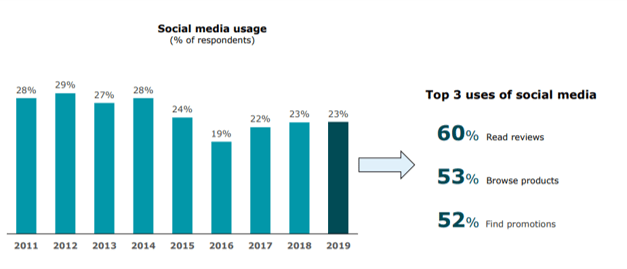
5. Go all-in with social media
We already know that social media is a huge purchase machine.
As many as 74% of consumers make purchasing decisions using social media platforms—which is why brands allocated a quarter of their annual budgets to holiday social media marketing.
It’s smart to make social media the foundations of your holiday marketing strategies. So, start thinking about how you can use platforms like Facebook, Twitter, and Instagram to reach people who are buying holiday gifts.
Here are some examples:
- Use UGC from customers: Influencer marketing is a popular way to promote your brand or products on social media. However, user-generated content is 9.8x more impactful than influencer content when making a purchasing decision. Grab testimonials, photos, and videos that your customers have created and use that as your social media content during the holiday season.
- Include hashtags: Hashtags allow your social media content to be seen by people who don’t already follow your branded profiles—especially now that Instagram allows users to follow hashtags. Hop onto seasonal hashtags, such as #ValentinesDay or #HappyHolidays to reach people browsing them.
- Point people to an online gift-giving quiz: Interactive content, such as a quiz, urges people to engage. This is the chance to recommend personalized products. Use social media to promote this quiz to direct followers back to your website.
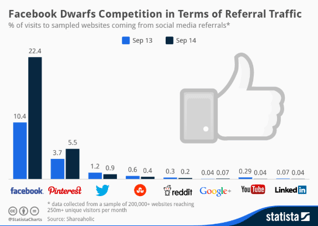
- Another great way to elevate your social media holiday marketing is using holiday language like December quotes in your captions. By doing this, the post will resonate more given the time of the year.
6. Sync brick-and-mortar with online
These days, we think that eCommerce dominates holiday sales. But sales from brick-and-mortar stores during the holiday season total more than you’d imagine.
It was reported that revenue from brick-and-mortar comprised $869.4 billion during the last holiday season. Plus, customers say they do 59% online shopping and 36% in-store shopping—proving sales do happen away from the internet.
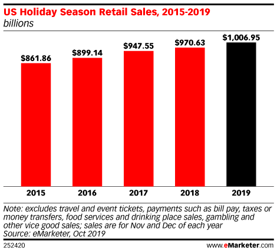
Limiting your holiday marketing strategies to online-only means you’d miss out on those sales.
However, it’s not a choice between one or the other. You can sync your brick-and-mortar stores with your online marketing campaign to get more holiday sales.
You can do this by:
- Getting customers to take photos and upload online to enter a giveaway: This is a superb way to create user-generated content, whilst also enticing in-store customers to follow you online. Starbucks is infamous for this. They run a contest each year for people to doodle on their red cups.
- Using social media to advertise offers to people within a 10-mile radius of your store: Facebook Ads allow you to target people within a certain radius of your brick-and-mortar store. Use your promotions to entice them in.
- Allowing in-store customers to pay using apps: It’s estimated that the digital payments market will be worth $6.7 trillion by 2023. Get in on the action, and encourage online customers to visit your stores by allowing them to pay using their app. You can also gamify the experience by allowing them to collect points.
7. Lean into retargeting
Every business has a sales funnel that customers pass through on their way to purchase.
People at the top of the funnel are unfamiliar with your product. They don’t know or trust you yet, so it’ll take much longer for them to pass through and end up purchasing an item.
However, people who already know and trust your brand are further down the sales funnel. You don’t need to educate them or get them to trust you. They might already have that built from previous interactions with you.
This means there’s less barrier to converting people who already know you. Those people should be your main focus during the holiday season because time is short.
There are various groups of people you can retarget with platforms like Facebook and Google Ads, including:
- All website visitors
- Visitors to specific webpages
- People who’ve liked your Facebook Page
- People who’ve abandoned their online shopping cart
- All previous customers
- People who’ve engaged with previous Facebook posts
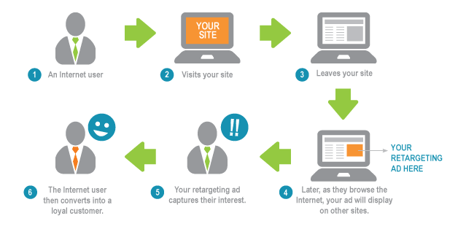
Regardless of which retargeting audience you choose, they’re all further along the funnel than people who’ve never heard of your brand. They need fewer nudges to purchase—which can boost the ROI of your holiday ads.
8. Lay off the A/B tests
A/B testing is a superb marketing practice that makes sure you’re not wasting time (or money) on poorly performing campaigns.
Yet whilst you might be planning months in advance, the peak time to run your holiday marketing campaigns is short. By the time you’ve got enough data from A/B testing, the peak time for selling might be over.
Instead, use data from your previous marketing activities to make decisions about your upcoming campaign. This can include results from last years’ holiday season if you run special promotions then.

For example, you might figure out that last year, Valentine’s Day emails with heart emojis in the subject line got double the amount of opens. Or, Christmas-themed blog posts you published in November got three times more conversions than others.
Figure out what works—and double down on that.
(If this is your first holiday campaign, don’t panic. The data on which channels, messaging, and content works best from this holiday marketing campaign can be used again next year.)
9. Use automation
When it comes to holiday marketing strategies, don’t get down in the weeds doing things manually. The more you can automate your holiday campaigns, the more time you’ll have to double-down on what’s working as you go.
Remember: the holiday season comes and goes faster than you anticipate. There’s no time for split-testing, nor spending hours doing a task that can be automated in five minutes.
There are hundreds of automation tools you can use to save time on the back-end and make the sales process run smoothly during each holiday season.
Here are some example tasks that you can automate using Atom8:
Apply membership price to specific customer groups
Workflow 1
WHEN: Order is created
IF: Product name contains “Garden Membership”
THEN: Add customer to “Garden Membership” group

Workflow 2
WHEN: 15:50 Daily (Triggered by time)
IF: Product category is “Garden”
THEN: Publish price list to “Garden Membership” group
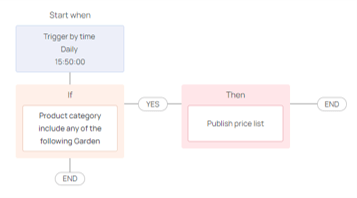
Apply discounts on multiple products
WHEN: Holiday campaign starts (triggered by time)
IF: Product category is “Last chance”
THEN: Change product sale price
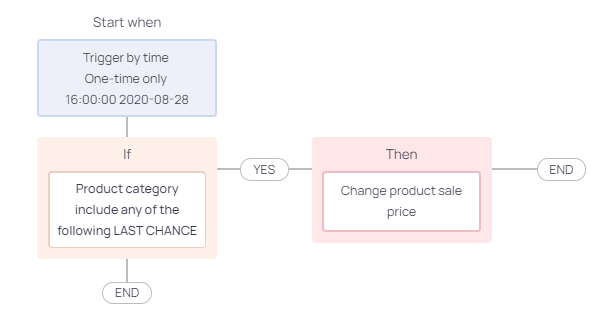
Switch website themes/ banners on schedule
WHEN: Holiday campaign starts (triggered by time)
THEN: Constantly change multiple themes/ banner ads for different promotion offers

Case study
How SunglassLA increased their revenue by 50% with optimal efficiency in their 2020 Summer Sales Campaign
Like most fashion stores, sales campaigns are great opportunities for Sunglass LA to boost up their revenue & increase customer relations. Over the week of Black Friday’s big sales campaign, Sunglass LA had its eyes set on multiple discount programs for each group of customers based on their total lifetime spending.
This required the team to execute quite a few challenging and arduous tasks.”We truly had a painful time of manually executing all the tedious and repetitive tasks over and over again”Viet Tran – CEO, SunglassLA
Key takeaways
As you can see, holiday marketing strategis don’t have to be complex. They can be anything from a simple thread of tweets, right the way through to a full-scale TV advertisement.
The most important thing to remember is you should never start planning the night before the big date. It takes time to plan out your ideas, design the creatives, and get sign-off.
It sounds like a lot of work for one small period but remembers: the holiday seasons are some of the biggest times for spending. Make sure you take advantage whilst you can.






